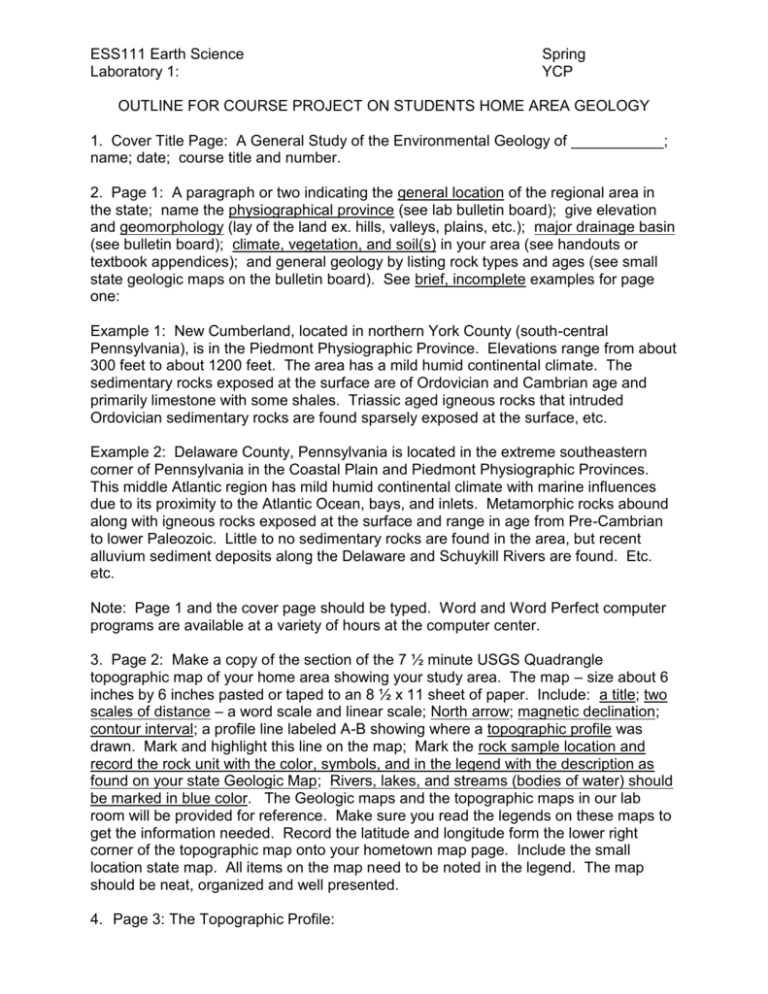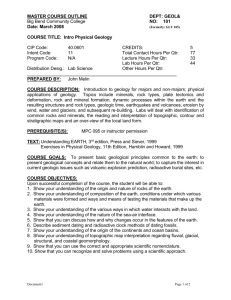Project Outline - York College of Pennsylvania
advertisement

ESS111 Earth Science Laboratory 1: Spring YCP OUTLINE FOR COURSE PROJECT ON STUDENTS HOME AREA GEOLOGY 1. Cover Title Page: A General Study of the Environmental Geology of ___________; name; date; course title and number. 2. Page 1: A paragraph or two indicating the general location of the regional area in the state; name the physiographical province (see lab bulletin board); give elevation and geomorphology (lay of the land ex. hills, valleys, plains, etc.); major drainage basin (see bulletin board); climate, vegetation, and soil(s) in your area (see handouts or textbook appendices); and general geology by listing rock types and ages (see small state geologic maps on the bulletin board). See brief, incomplete examples for page one: Example 1: New Cumberland, located in northern York County (south-central Pennsylvania), is in the Piedmont Physiographic Province. Elevations range from about 300 feet to about 1200 feet. The area has a mild humid continental climate. The sedimentary rocks exposed at the surface are of Ordovician and Cambrian age and primarily limestone with some shales. Triassic aged igneous rocks that intruded Ordovician sedimentary rocks are found sparsely exposed at the surface, etc. Example 2: Delaware County, Pennsylvania is located in the extreme southeastern corner of Pennsylvania in the Coastal Plain and Piedmont Physiographic Provinces. This middle Atlantic region has mild humid continental climate with marine influences due to its proximity to the Atlantic Ocean, bays, and inlets. Metamorphic rocks abound along with igneous rocks exposed at the surface and range in age from Pre-Cambrian to lower Paleozoic. Little to no sedimentary rocks are found in the area, but recent alluvium sediment deposits along the Delaware and Schuykill Rivers are found. Etc. etc. Note: Page 1 and the cover page should be typed. Word and Word Perfect computer programs are available at a variety of hours at the computer center. 3. Page 2: Make a copy of the section of the 7 ½ minute USGS Quadrangle topographic map of your home area showing your study area. The map – size about 6 inches by 6 inches pasted or taped to an 8 ½ x 11 sheet of paper. Include: a title; two scales of distance – a word scale and linear scale; North arrow; magnetic declination; contour interval; a profile line labeled A-B showing where a topographic profile was drawn. Mark and highlight this line on the map; Mark the rock sample location and record the rock unit with the color, symbols, and in the legend with the description as found on your state Geologic Map; Rivers, lakes, and streams (bodies of water) should be marked in blue color. The Geologic maps and the topographic maps in our lab room will be provided for reference. Make sure you read the legends on these maps to get the information needed. Record the latitude and longitude form the lower right corner of the topographic map onto your hometown map page. Include the small location state map. All items on the map need to be noted in the legend. The map should be neat, organized and well presented. 4. Page 3: The Topographic Profile: On an 8 ½ by 11 inch sheet of graph paper, having 4 or 5 blocks to the inch, draw the topographic profile marked on your topographic map – see page 2. The profile should be about four to six inches in length. If possible, take the profile line through the area where the rock sample, described on Page 4, was found. The horizontal scale is the same as on the topographic map scale. The vertical scale should be 1 inch equals 400 feet if the local relief along the profile line is greater than 400 feet; use one inch equals 200 feet for local relief between 100 and 400 feet; use one inch equals 100 feet for local relief less than 100 feet. The profile graph should have a title; compass directions; a vertical and horizontal scale, and rock sample location marked with the symbols and colors found on your state geologic map. Also include a rock unit description found in the legend on the large state geologic map on file in our lab room. You will need to get your own graph paper. A legend is needed on the profile page. 5. For Page 4: use the Rock Sample Description handout available in the lab. Complete this page from your rock sample. Examples are available in the lab. Refer to your laboratory manual and rock lab sheets to help complete this page. READ CAREFULLY 6. Page 5 ; Geologic feature page: Using the designated handout, describe an outstanding scenic geologic feature within an one hundred and fifty mile radius from your home. You may need to refer to your laboratory manual for this page to describe the rock. 7. Pages 6 and 7 are your birthstone and zodiac pages which are part of the hometown project.





